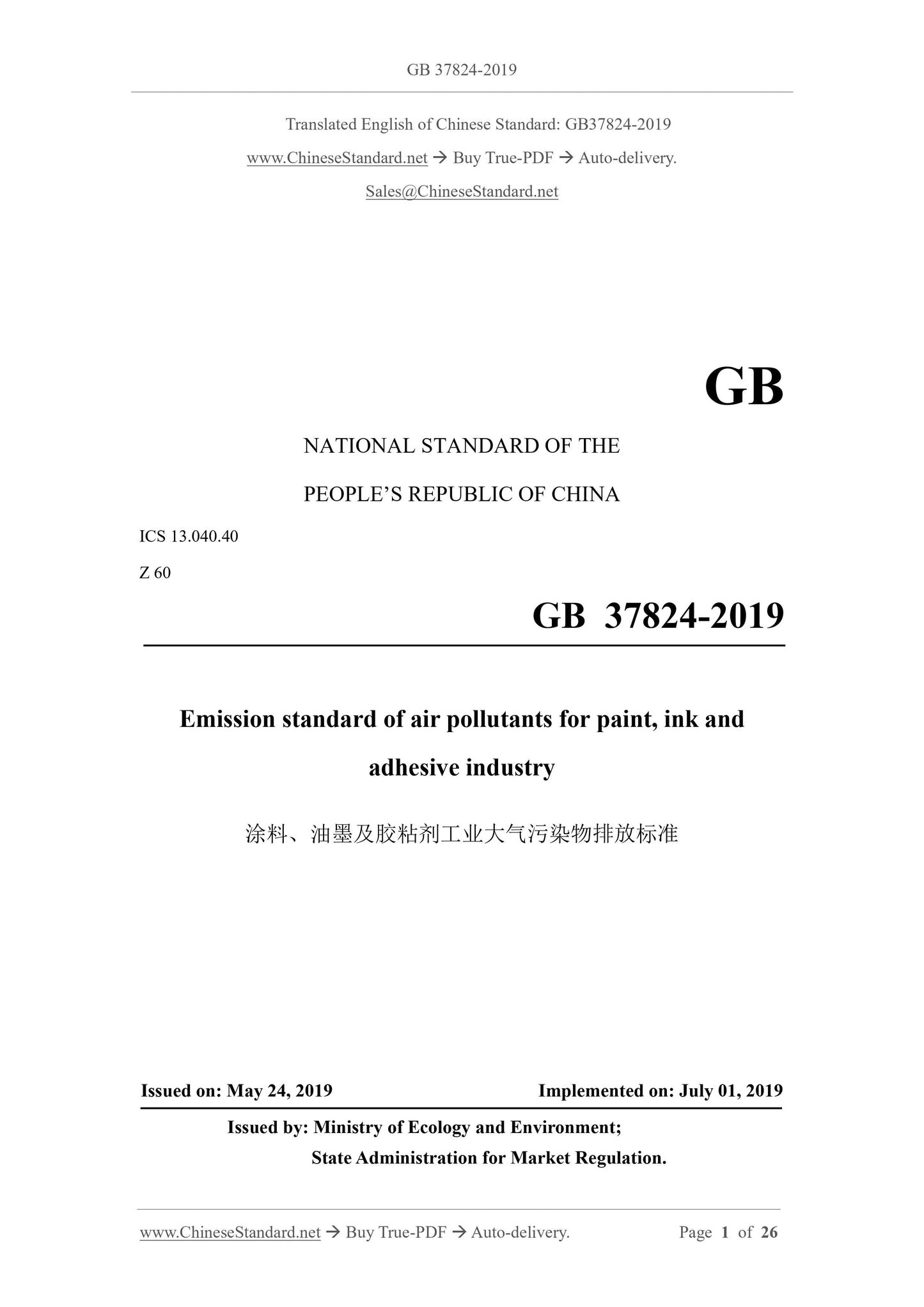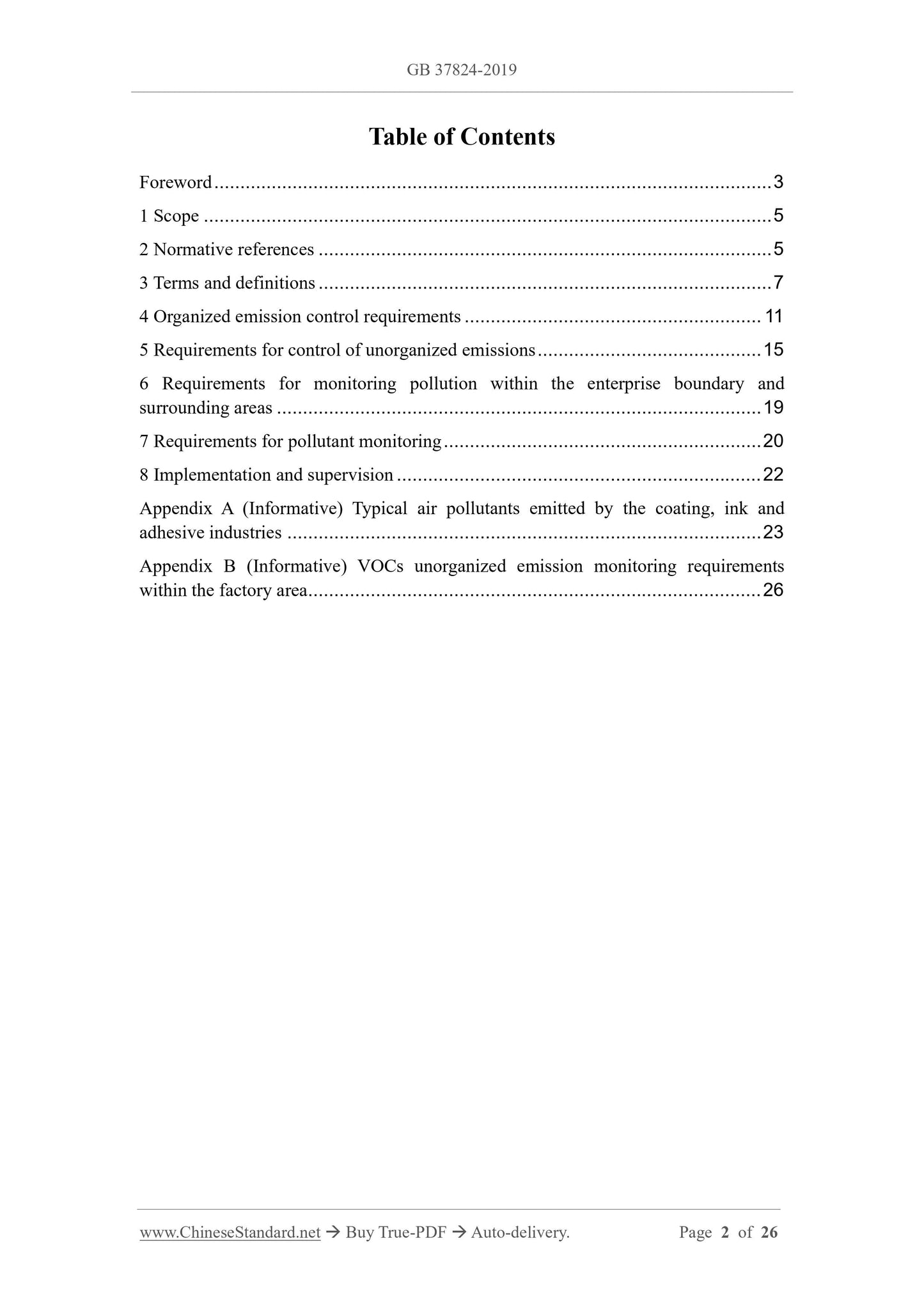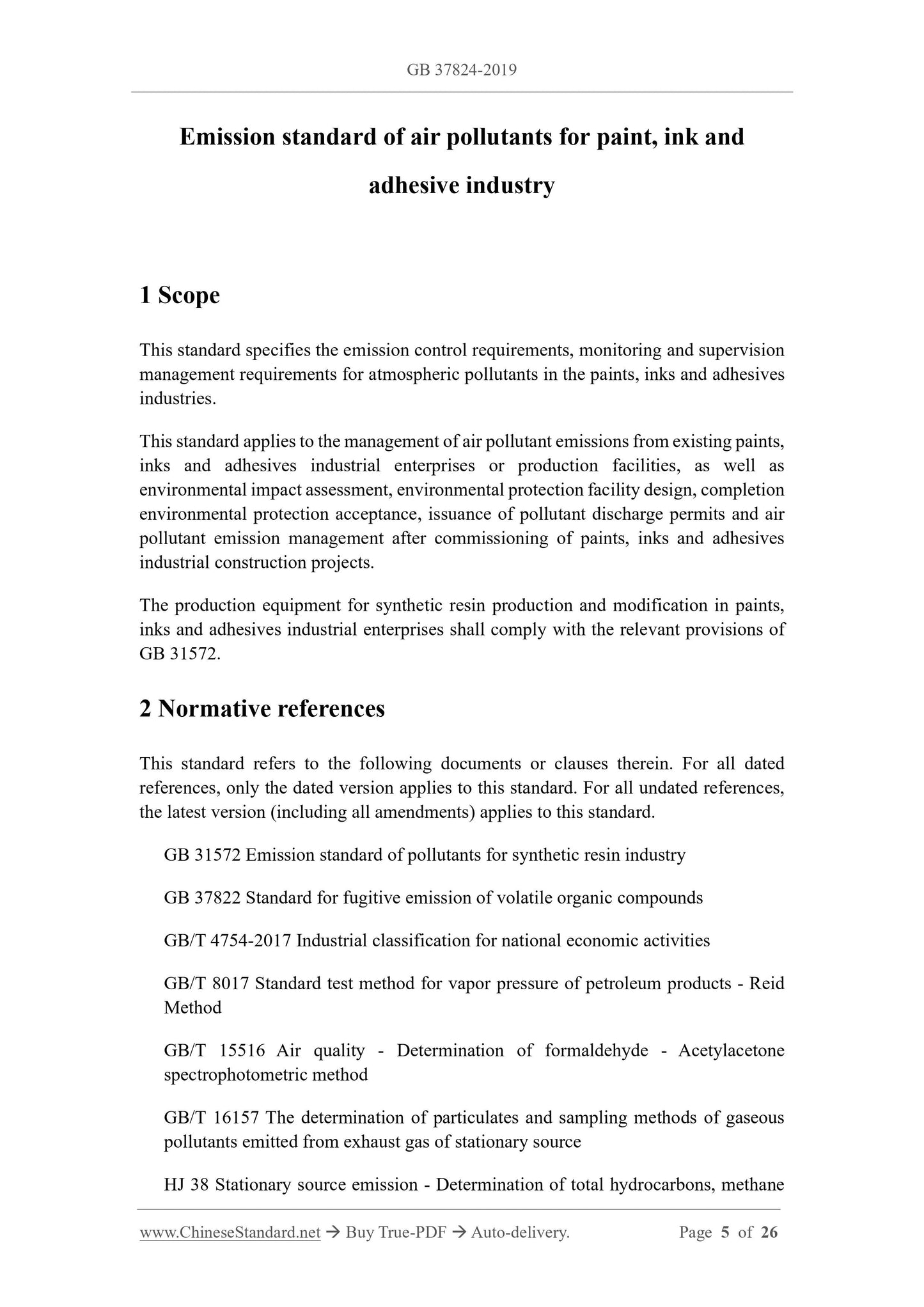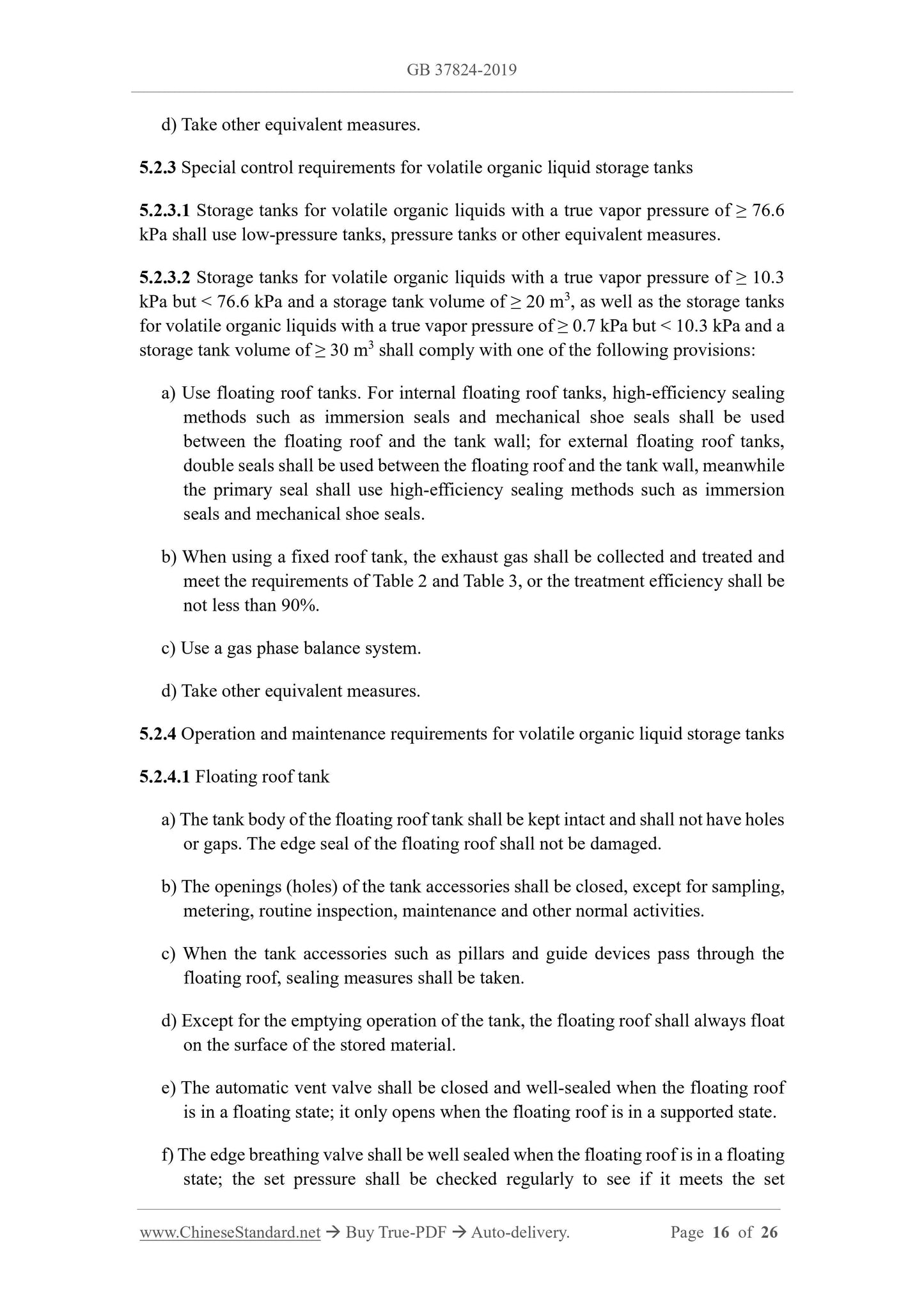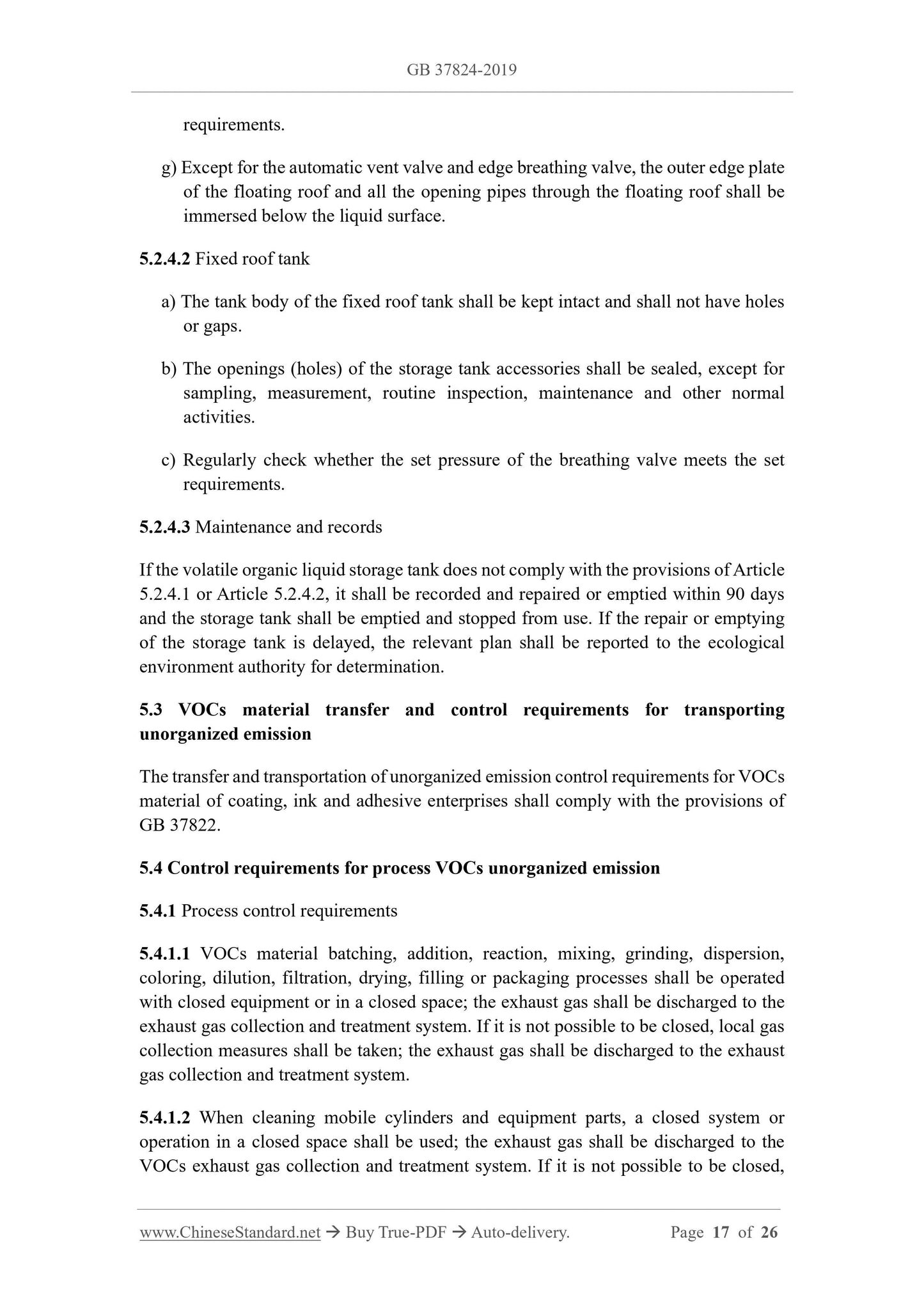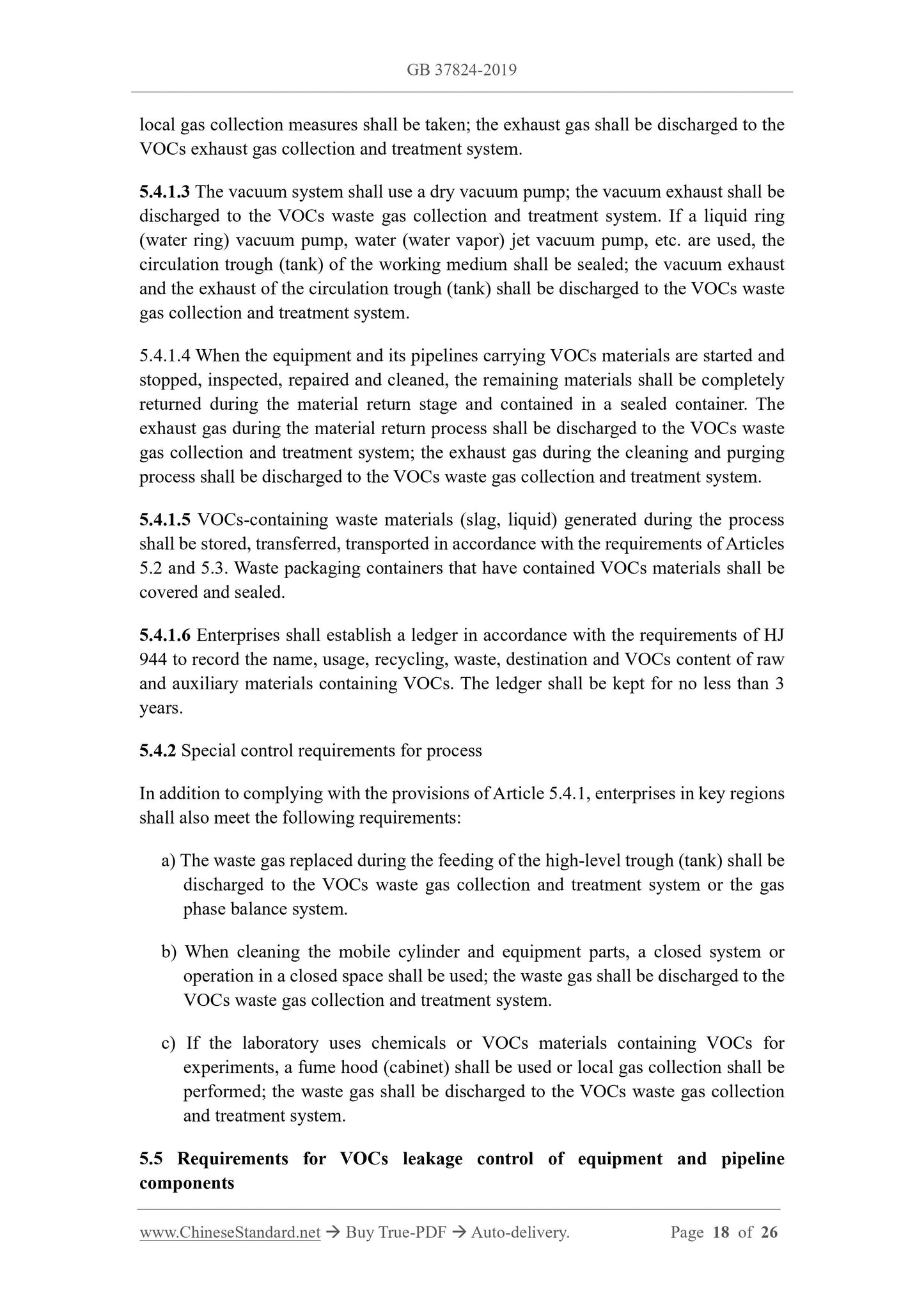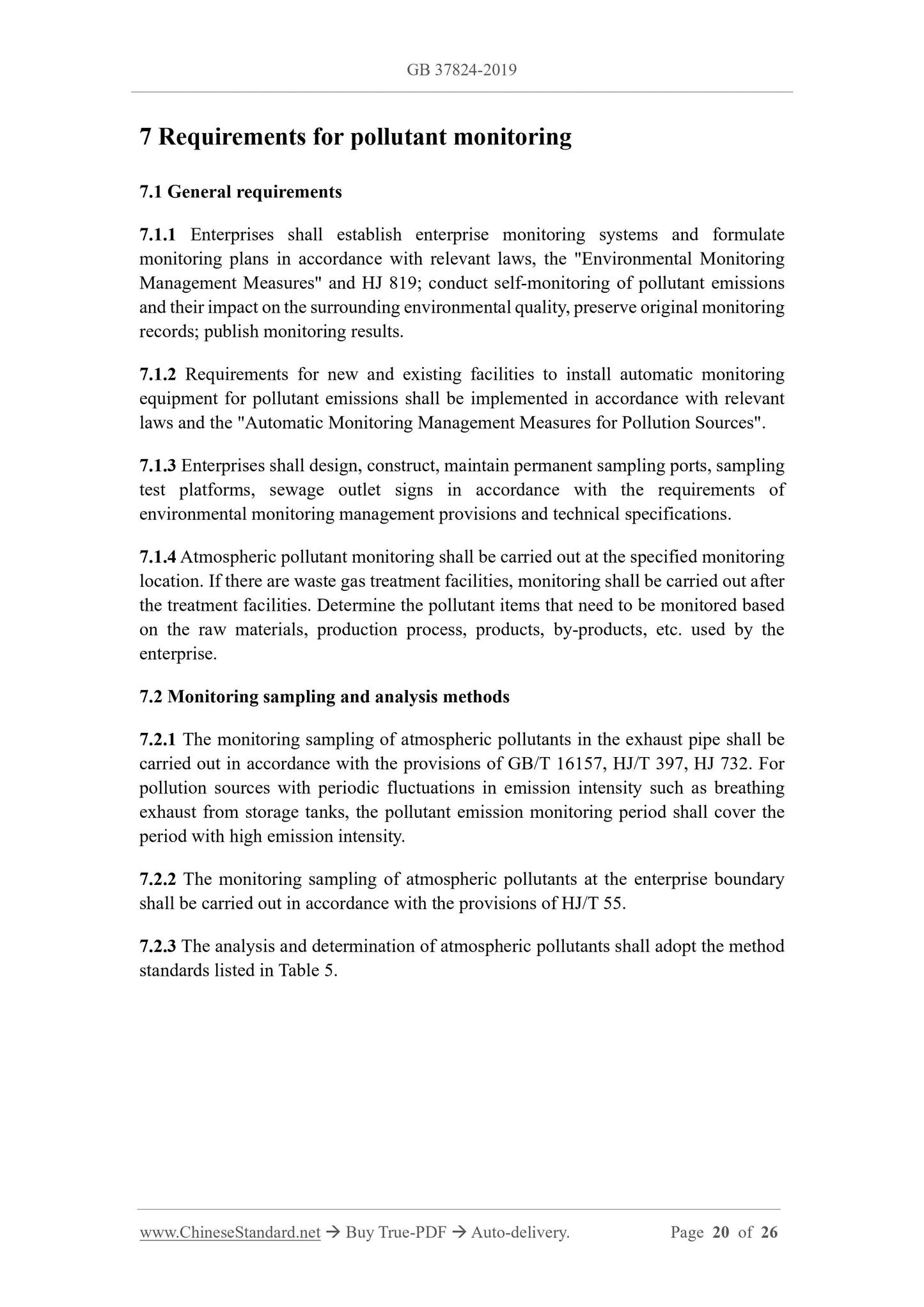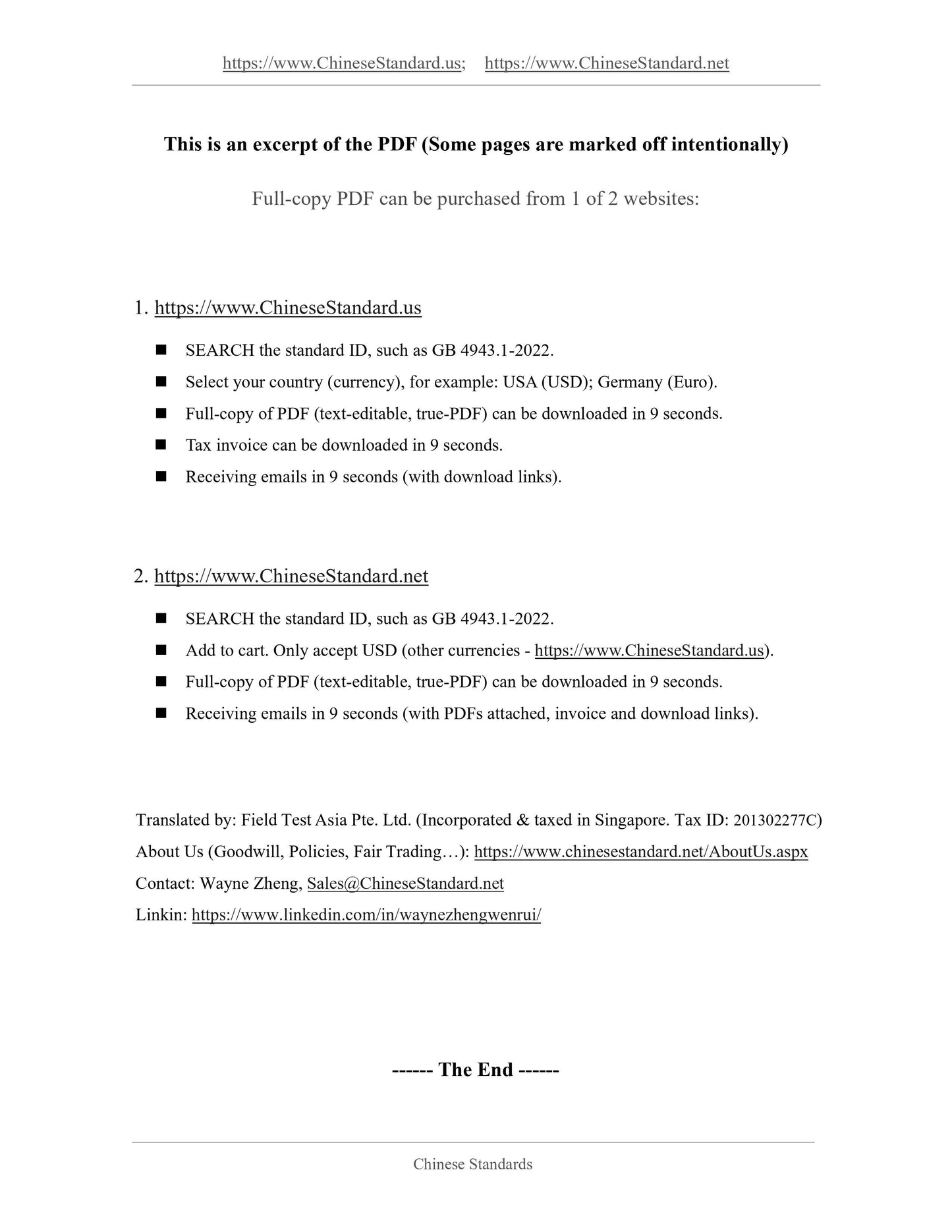1
/
of
9
www.ChineseStandard.us -- Field Test Asia Pte. Ltd.
GB 37824-2019 English PDF
GB 37824-2019 English PDF
Regular price
$255.00
Regular price
Sale price
$255.00
Unit price
/
per
Shipping calculated at checkout.
Couldn't load pickup availability
GB 37824-2019: Emission standard of air pollutants for paint, ink and adhesive industry
Delivery: 9 seconds. Download (& Email) true-PDF + Invoice.
Get Quotation: Click GB 37824-2019 (Self-service in 1-minute)
Historical versions (Master-website): GB 37824-2019
Preview True-PDF (Reload/Scroll-down if blank)
GB 37824-2019
GB
NATIONAL STANDARD OF THE
PEOPLE’S REPUBLIC OF CHINA
ICS 13.040.40
Z 60
Emission standard of air pollutants for paint, ink and
adhesive industry
ISSUED ON. MAY 24, 2019
IMPLEMENTED ON. JULY 01, 2019
Issued by. Ministry of Ecology and Environment;
State Administration for Market Regulation.
Table of Contents
Foreword... 3
1 Scope... 5
2 Normative references... 5
3 Terms and definitions... 7
4 Organized emission control requirements... 11
5 Requirements for control of unorganized emissions... 15
6 Requirements for monitoring pollution within the enterprise boundary and
surrounding areas... 19
7 Requirements for pollutant monitoring... 20
8 Implementation and supervision... 22
Appendix A (Informative) Typical air pollutants emitted by the coating, ink and
adhesive industries... 23
Appendix B (Informative) VOCs unorganized emission monitoring requirements
within the factory area... 26
Emission standard of air pollutants for paint, ink and
adhesive industry
1 Scope
This standard specifies the emission control requirements, monitoring and supervision
management requirements for atmospheric pollutants in the paints, inks and adhesives
industries.
This standard applies to the management of air pollutant emissions from existing paints,
inks and adhesives industrial enterprises or production facilities, as well as
environmental impact assessment, environmental protection facility design, completion
environmental protection acceptance, issuance of pollutant discharge permits and air
pollutant emission management after commissioning of paints, inks and adhesives
industrial construction projects.
The production equipment for synthetic resin production and modification in paints,
inks and adhesives industrial enterprises shall comply with the relevant provisions of
GB 31572.
2 Normative references
This standard refers to the following documents or clauses therein. For all dated
references, only the dated version applies to this standard. For all undated references,
the latest version (including all amendments) applies to this standard.
GB 31572 Emission standard of pollutants for synthetic resin industry
GB 37822 Standard for fugitive emission of volatile organic compounds
GB/T 4754-2017 Industrial classification for national economic activities
GB/T 8017 Standard test method for vapor pressure of petroleum products - Reid
Method
GB/T 15516 Air quality - Determination of formaldehyde - Acetylacetone
spectrophotometric method
GB/T 16157 The determination of particulates and sampling methods of gaseous
pollutants emitted from exhaust gas of stationary source
HJ 38 Stationary source emission - Determination of total hydrocarbons, methane
from the exhaust stack, they shall be monitored before mixing and the corresponding
emission control requirements shall be implemented. If the optional monitoring location
can only monitor the mixed exhaust gas, it shall be implemented according to the most
stringent provisions of each emission control requirement.
5 Requirements for control of unorganized emissions
5.1 Scope and time of implementation
5.1.1 From July 1, 2019 for new facilities and from July 1, 2020 for existing facilities,
unorganized emission control shall be implemented in accordance with the provisions
of this standard.
5.1.2 Enterprises in key regions shall implement special control requirements for
unorganized emissions; the geographical scope and time of implementation shall be
determined by the ecological environment department of the State Council or the
provincial people's government.
5.2 Requirements for control of unorganized emissions from VOCs material
storage
5.2.1 Except for volatile organic liquid storage tanks, the control requirements for
unorganized emissions from VOCs material storage in paints, inks and adhesives
enterprises shall comply with the provisions of GB 37822.
5.2.2 Control requirements for volatile organic liquid storage tanks
5.2.2.1 Storage tanks for volatile organic liquids with a true vapor pressure of ≥ 76.6
kPa shall use low-pressure tanks, pressure tanks or other equivalent measures.
5.2.2.2 Storage tanks for volatile organic liquids with a true vapor pressure of ≥ 10.3
kPa but < 76.6 kPa and a storage tank volume of ≥ 30 m3 shall comply with one of the
following provisions.
a) Use floating roof tanks. For internal floating roof tanks, high-efficiency sealing
methods such as immersion seals and mechanical shoe seals shall be used
between the floating roof and the tank wall; for external floating roof tanks,
double seals shall be used between the floating roof and the tank wall, meanwhile
the primary seal shall use high-efficiency sealing methods such as immersion
seals and mechanical shoe seals.
b) Use fixed roof tanks; the exhaust gas discharged shall be collected and treated and
meet the requirements of Table 1 and Table 3, or the treatment efficiency shall be
not less than 80%.
c) Use a gas phase balance system.
d) Take other equivalent measures.
5.2.3 Special control requirements for volatile organic liquid storage tanks
5.2.3.1 Storage tanks for volatile organic liquids with a true vapor pressure of ≥ 76.6
kPa shall use low-pressure tanks, pressure tanks or other equivalent measures.
5.2.3.2 Storage tanks for volatile organic liquids with a true vapor pressure of ≥ 10.3
kPa but < 76.6 kPa and a storage tank volume of ≥ 20 m3, as well as the storage tanks
for volatile organic liquids with a true vapor pressure of ≥ 0.7 kPa but < 10.3 kPa and a
storage tank volume of ≥ 30 m3 shall comply with one of the following provisions.
a) Use floating roof tanks. For internal floating roof tanks, high-efficiency sealing
methods such as immersion seals and mechanical shoe seals shall be used
between the floating roof and the tank wall; for external floating roof tanks,
double seals shall be used between the floating roof and the tank wall, meanwhile
the primary seal shall use high-efficiency sealing methods such as immersion
seals and mechanical shoe seals.
b) When using a fixed roof tank, the exhaust gas shall be collected and treated and
meet the requirements of Table 2 and Table 3, or the treatment efficiency shall be
not less than 90%.
c) Use a gas phase balance system.
d) Take other equivalent measures.
5.2.4 Operation and maintenance requirements for volatile organic liquid storage tanks
5.2.4.1 Floating roof tank
a) The tank body of the floating roof tank shall be kept intact and shall not have holes
or gaps. The edge seal of the floating roof shall not be damaged.
b) The openings (holes) of the tank accessories shall be closed, except for sampling,
metering, routine inspection, maintenance and other normal activities.
c) When the tank accessories such as pillars and guide devices pass through the
floating roof, sealing measures shall be taken.
d) Except for the emptying operation of the tank, the floating roof shall always float
on the surface of the stored material.
e) The automatic vent valve shall be closed and well-sealed when the floating roof
is in a floating state; it only opens when the floating roof is in a supported state.
f) The edge breathing valve shall be well sealed when the floating roof is in a floating
state; the set pressure shall be checked regularly to see if it meets the set
requirements.
g) Except for the automatic vent valve and edge breathing valve, the outer edge plate
of the floating roof and all the opening pipes through the floating roof shall be
immersed below the liquid surface.
5.2.4.2 Fixed roof tank
a) The tank body of the fixed roof tank shall be kept intact and shall not have holes
or gaps.
b) The openings (holes) of the storage tank accessories shall be sealed, except for
sampling, measurement, routine inspection, maintenance and other normal
activities.
c) Regularly check whether the set pressure of the breathing valve meets the set
requirements.
5.2.4.3 Maintenance and records
If the volatile organic liquid storage tank does not comply with the provisions of Article
5.2.4.1 or Article 5.2.4.2, it shall be recorded and repaired or emptied within 90 days
and the storage tank shall be emptied and stopped from use. If the repair or emptying
of the storage tank is delayed, the relevant plan shall be reported to the ecological
environment authority for determination.
5.3 VOCs material transfer and control requirements for transporting
unorganized emission
The transfer and transportation of unorganized emission control requirements for VOCs
material of coating, ink and adhesive enterprises shall comply with the provisions of
GB 37822.
5.4 Control requirements for process VOCs unorganized emission
5.4.1 Process control requirements
5.4.1.1 VOCs material batching, addition, reaction, mixing, grinding, dispersion,
coloring, dilution, filtration, drying, filling or packaging processes shall be operated
with closed equipment or in a closed space; the exhaust gas shall be discharged to the
exhaust gas collection and treatment system. If it is not possible to be closed, local gas
collection measures shall be taken; the exhaust gas shall be discharged to the exhaust
gas collection and treatment system.
5.4.1.2 When cleaning mobile cylinders and equipment parts, a closed system or
operation in a closed space shall be used; the exhaust gas shall be discharged to the
VOCs exhaust gas collection and treatment system. If it is not possible to be closed,
local gas collection measures shall be taken; the exhaust gas shall be discharged to the
VOCs exhaust gas collection and treatment system.
5.4.1.3 The vacuum system shall use a dry vacuum pump; the vacuum exhaust shall be
discharged to the VOCs waste gas collection and treatment system. If a liquid ring
(water ring) vacuum pump, water (water vapor) jet vacuum pump, etc. are used, the
circulation trough (tank) of the working medium shall be sealed; the vacuum exhaust
and the exhaust of the circulation trough (tank) shall be discharged to the VOCs waste
gas collection and treatment system.
5.4.1.4 When the equipment and its pipelines carrying VOCs materials are started and
stopped, inspected, repaired and cleaned, the remaining materials shall be completely
returned during the material return stage and contained in a sealed container. The
exhaust gas during the material return process shall be discharged to the VOCs waste
gas collection and treatment system; the exhaust gas during the cleaning and purging
process shall be discharged to the VOCs waste gas collection and treatment system.
5.4.1.5 VOCs-containing waste materials (slag, liquid) generated during the process
shall be stored, transferred, transported in accordance with the requirements of Articles
5.2 and 5.3.Waste packaging containers that have contained VOCs materials shall be
covered and sealed.
5.4.1.6 Enterprises shall establish a ledger in accordance with the requirements of HJ
944 to record the name, usage, recycling, waste, destination and VOCs content of raw
and auxiliary materials containing VOCs. The ledger shall be kept for no less than 3
years.
5.4.2 Special control requirements for process
In addition to complying with the provisions of Article 5.4.1, enterprises in key regions
shall also meet the following requirements.
a) The waste gas replaced during the feeding of the high-level trough (tank) shall be
discharged to the VOCs waste gas collection and treatment system or the gas
phase balance system.
b) When cleaning the mobile cylinder and equipment parts, a closed system or
operation in a closed space shall be used; the waste gas shall be discharged to the
VOCs waste gas collection and treatment system.
c) If the laboratory uses chemicals or VOCs materials containing VOCs for
experiments, a fume hood (cabinet) shall be used or local gas collection shall be
performed; the waste gas shall be discharged to the VOCs waste gas collection
and treatment system.
5.5 Requirements for VOCs leakage control of equipment and pipeline
components
7 Requirements for pollutant monitoring
7.1 General requirements
7.1.1 Enterprises shall establish enterprise monitoring systems and formulate
monitoring plans in accordance with relevant laws, the "Environmental Monitoring
Management Measures" and HJ 819; conduct self-monitoring of pollutant emissions
and their impact on the surrounding environmental quality, preserve original monitoring
records; publish monitoring results.
7.1.2 Requirements for new and existing facilities to install automatic monitoring
equipment for pollutant emissions shall be implemented in accordance with relevant
laws and the "Automatic Monitoring Management Measures for Pollution Sources".
7.1.3 Enterprises shall design, construct, maintain permanent sampling ports, sampling
test platforms, sewage outlet signs in accordance with the requirements of
environmental monitoring management provisions and technical specifications.
7.1.4 Atmospheric pollutant monitoring shall be carried out at the specified monitoring
location. If there are waste gas treatment facilities, monitoring shall be carried out after
the treatment facilities. Determine the pollutant items that need to be monitored based
on the raw materials, production process, products, by-products, etc. used by the
enterprise.
7.2 Monitoring sampling and analysis methods
7.2.1 The monitoring sampling of atmospheric pollutants in the exhaust pipe shall be
carried out in accordance with the provisions of GB/T 16157, HJ/T 397, HJ 732.For
pollution sources with periodic fluctuations in emission intensity such as breathing
exhaust from storage tanks, the pollutant emission monitoring period shall cover the
period with high emission intensity.
7.2.2 The monitoring sampling of atmospheric pollutants at the enterprise boundary
shall be carried out in accordance with the provisions of HJ/T 55.
7.2.3 The analysis and determination of atmospheric pollutants shall adopt the method
standards listed in Tab...
Delivery: 9 seconds. Download (& Email) true-PDF + Invoice.
Get Quotation: Click GB 37824-2019 (Self-service in 1-minute)
Historical versions (Master-website): GB 37824-2019
Preview True-PDF (Reload/Scroll-down if blank)
GB 37824-2019
GB
NATIONAL STANDARD OF THE
PEOPLE’S REPUBLIC OF CHINA
ICS 13.040.40
Z 60
Emission standard of air pollutants for paint, ink and
adhesive industry
ISSUED ON. MAY 24, 2019
IMPLEMENTED ON. JULY 01, 2019
Issued by. Ministry of Ecology and Environment;
State Administration for Market Regulation.
Table of Contents
Foreword... 3
1 Scope... 5
2 Normative references... 5
3 Terms and definitions... 7
4 Organized emission control requirements... 11
5 Requirements for control of unorganized emissions... 15
6 Requirements for monitoring pollution within the enterprise boundary and
surrounding areas... 19
7 Requirements for pollutant monitoring... 20
8 Implementation and supervision... 22
Appendix A (Informative) Typical air pollutants emitted by the coating, ink and
adhesive industries... 23
Appendix B (Informative) VOCs unorganized emission monitoring requirements
within the factory area... 26
Emission standard of air pollutants for paint, ink and
adhesive industry
1 Scope
This standard specifies the emission control requirements, monitoring and supervision
management requirements for atmospheric pollutants in the paints, inks and adhesives
industries.
This standard applies to the management of air pollutant emissions from existing paints,
inks and adhesives industrial enterprises or production facilities, as well as
environmental impact assessment, environmental protection facility design, completion
environmental protection acceptance, issuance of pollutant discharge permits and air
pollutant emission management after commissioning of paints, inks and adhesives
industrial construction projects.
The production equipment for synthetic resin production and modification in paints,
inks and adhesives industrial enterprises shall comply with the relevant provisions of
GB 31572.
2 Normative references
This standard refers to the following documents or clauses therein. For all dated
references, only the dated version applies to this standard. For all undated references,
the latest version (including all amendments) applies to this standard.
GB 31572 Emission standard of pollutants for synthetic resin industry
GB 37822 Standard for fugitive emission of volatile organic compounds
GB/T 4754-2017 Industrial classification for national economic activities
GB/T 8017 Standard test method for vapor pressure of petroleum products - Reid
Method
GB/T 15516 Air quality - Determination of formaldehyde - Acetylacetone
spectrophotometric method
GB/T 16157 The determination of particulates and sampling methods of gaseous
pollutants emitted from exhaust gas of stationary source
HJ 38 Stationary source emission - Determination of total hydrocarbons, methane
from the exhaust stack, they shall be monitored before mixing and the corresponding
emission control requirements shall be implemented. If the optional monitoring location
can only monitor the mixed exhaust gas, it shall be implemented according to the most
stringent provisions of each emission control requirement.
5 Requirements for control of unorganized emissions
5.1 Scope and time of implementation
5.1.1 From July 1, 2019 for new facilities and from July 1, 2020 for existing facilities,
unorganized emission control shall be implemented in accordance with the provisions
of this standard.
5.1.2 Enterprises in key regions shall implement special control requirements for
unorganized emissions; the geographical scope and time of implementation shall be
determined by the ecological environment department of the State Council or the
provincial people's government.
5.2 Requirements for control of unorganized emissions from VOCs material
storage
5.2.1 Except for volatile organic liquid storage tanks, the control requirements for
unorganized emissions from VOCs material storage in paints, inks and adhesives
enterprises shall comply with the provisions of GB 37822.
5.2.2 Control requirements for volatile organic liquid storage tanks
5.2.2.1 Storage tanks for volatile organic liquids with a true vapor pressure of ≥ 76.6
kPa shall use low-pressure tanks, pressure tanks or other equivalent measures.
5.2.2.2 Storage tanks for volatile organic liquids with a true vapor pressure of ≥ 10.3
kPa but < 76.6 kPa and a storage tank volume of ≥ 30 m3 shall comply with one of the
following provisions.
a) Use floating roof tanks. For internal floating roof tanks, high-efficiency sealing
methods such as immersion seals and mechanical shoe seals shall be used
between the floating roof and the tank wall; for external floating roof tanks,
double seals shall be used between the floating roof and the tank wall, meanwhile
the primary seal shall use high-efficiency sealing methods such as immersion
seals and mechanical shoe seals.
b) Use fixed roof tanks; the exhaust gas discharged shall be collected and treated and
meet the requirements of Table 1 and Table 3, or the treatment efficiency shall be
not less than 80%.
c) Use a gas phase balance system.
d) Take other equivalent measures.
5.2.3 Special control requirements for volatile organic liquid storage tanks
5.2.3.1 Storage tanks for volatile organic liquids with a true vapor pressure of ≥ 76.6
kPa shall use low-pressure tanks, pressure tanks or other equivalent measures.
5.2.3.2 Storage tanks for volatile organic liquids with a true vapor pressure of ≥ 10.3
kPa but < 76.6 kPa and a storage tank volume of ≥ 20 m3, as well as the storage tanks
for volatile organic liquids with a true vapor pressure of ≥ 0.7 kPa but < 10.3 kPa and a
storage tank volume of ≥ 30 m3 shall comply with one of the following provisions.
a) Use floating roof tanks. For internal floating roof tanks, high-efficiency sealing
methods such as immersion seals and mechanical shoe seals shall be used
between the floating roof and the tank wall; for external floating roof tanks,
double seals shall be used between the floating roof and the tank wall, meanwhile
the primary seal shall use high-efficiency sealing methods such as immersion
seals and mechanical shoe seals.
b) When using a fixed roof tank, the exhaust gas shall be collected and treated and
meet the requirements of Table 2 and Table 3, or the treatment efficiency shall be
not less than 90%.
c) Use a gas phase balance system.
d) Take other equivalent measures.
5.2.4 Operation and maintenance requirements for volatile organic liquid storage tanks
5.2.4.1 Floating roof tank
a) The tank body of the floating roof tank shall be kept intact and shall not have holes
or gaps. The edge seal of the floating roof shall not be damaged.
b) The openings (holes) of the tank accessories shall be closed, except for sampling,
metering, routine inspection, maintenance and other normal activities.
c) When the tank accessories such as pillars and guide devices pass through the
floating roof, sealing measures shall be taken.
d) Except for the emptying operation of the tank, the floating roof shall always float
on the surface of the stored material.
e) The automatic vent valve shall be closed and well-sealed when the floating roof
is in a floating state; it only opens when the floating roof is in a supported state.
f) The edge breathing valve shall be well sealed when the floating roof is in a floating
state; the set pressure shall be checked regularly to see if it meets the set
requirements.
g) Except for the automatic vent valve and edge breathing valve, the outer edge plate
of the floating roof and all the opening pipes through the floating roof shall be
immersed below the liquid surface.
5.2.4.2 Fixed roof tank
a) The tank body of the fixed roof tank shall be kept intact and shall not have holes
or gaps.
b) The openings (holes) of the storage tank accessories shall be sealed, except for
sampling, measurement, routine inspection, maintenance and other normal
activities.
c) Regularly check whether the set pressure of the breathing valve meets the set
requirements.
5.2.4.3 Maintenance and records
If the volatile organic liquid storage tank does not comply with the provisions of Article
5.2.4.1 or Article 5.2.4.2, it shall be recorded and repaired or emptied within 90 days
and the storage tank shall be emptied and stopped from use. If the repair or emptying
of the storage tank is delayed, the relevant plan shall be reported to the ecological
environment authority for determination.
5.3 VOCs material transfer and control requirements for transporting
unorganized emission
The transfer and transportation of unorganized emission control requirements for VOCs
material of coating, ink and adhesive enterprises shall comply with the provisions of
GB 37822.
5.4 Control requirements for process VOCs unorganized emission
5.4.1 Process control requirements
5.4.1.1 VOCs material batching, addition, reaction, mixing, grinding, dispersion,
coloring, dilution, filtration, drying, filling or packaging processes shall be operated
with closed equipment or in a closed space; the exhaust gas shall be discharged to the
exhaust gas collection and treatment system. If it is not possible to be closed, local gas
collection measures shall be taken; the exhaust gas shall be discharged to the exhaust
gas collection and treatment system.
5.4.1.2 When cleaning mobile cylinders and equipment parts, a closed system or
operation in a closed space shall be used; the exhaust gas shall be discharged to the
VOCs exhaust gas collection and treatment system. If it is not possible to be closed,
local gas collection measures shall be taken; the exhaust gas shall be discharged to the
VOCs exhaust gas collection and treatment system.
5.4.1.3 The vacuum system shall use a dry vacuum pump; the vacuum exhaust shall be
discharged to the VOCs waste gas collection and treatment system. If a liquid ring
(water ring) vacuum pump, water (water vapor) jet vacuum pump, etc. are used, the
circulation trough (tank) of the working medium shall be sealed; the vacuum exhaust
and the exhaust of the circulation trough (tank) shall be discharged to the VOCs waste
gas collection and treatment system.
5.4.1.4 When the equipment and its pipelines carrying VOCs materials are started and
stopped, inspected, repaired and cleaned, the remaining materials shall be completely
returned during the material return stage and contained in a sealed container. The
exhaust gas during the material return process shall be discharged to the VOCs waste
gas collection and treatment system; the exhaust gas during the cleaning and purging
process shall be discharged to the VOCs waste gas collection and treatment system.
5.4.1.5 VOCs-containing waste materials (slag, liquid) generated during the process
shall be stored, transferred, transported in accordance with the requirements of Articles
5.2 and 5.3.Waste packaging containers that have contained VOCs materials shall be
covered and sealed.
5.4.1.6 Enterprises shall establish a ledger in accordance with the requirements of HJ
944 to record the name, usage, recycling, waste, destination and VOCs content of raw
and auxiliary materials containing VOCs. The ledger shall be kept for no less than 3
years.
5.4.2 Special control requirements for process
In addition to complying with the provisions of Article 5.4.1, enterprises in key regions
shall also meet the following requirements.
a) The waste gas replaced during the feeding of the high-level trough (tank) shall be
discharged to the VOCs waste gas collection and treatment system or the gas
phase balance system.
b) When cleaning the mobile cylinder and equipment parts, a closed system or
operation in a closed space shall be used; the waste gas shall be discharged to the
VOCs waste gas collection and treatment system.
c) If the laboratory uses chemicals or VOCs materials containing VOCs for
experiments, a fume hood (cabinet) shall be used or local gas collection shall be
performed; the waste gas shall be discharged to the VOCs waste gas collection
and treatment system.
5.5 Requirements for VOCs leakage control of equipment and pipeline
components
7 Requirements for pollutant monitoring
7.1 General requirements
7.1.1 Enterprises shall establish enterprise monitoring systems and formulate
monitoring plans in accordance with relevant laws, the "Environmental Monitoring
Management Measures" and HJ 819; conduct self-monitoring of pollutant emissions
and their impact on the surrounding environmental quality, preserve original monitoring
records; publish monitoring results.
7.1.2 Requirements for new and existing facilities to install automatic monitoring
equipment for pollutant emissions shall be implemented in accordance with relevant
laws and the "Automatic Monitoring Management Measures for Pollution Sources".
7.1.3 Enterprises shall design, construct, maintain permanent sampling ports, sampling
test platforms, sewage outlet signs in accordance with the requirements of
environmental monitoring management provisions and technical specifications.
7.1.4 Atmospheric pollutant monitoring shall be carried out at the specified monitoring
location. If there are waste gas treatment facilities, monitoring shall be carried out after
the treatment facilities. Determine the pollutant items that need to be monitored based
on the raw materials, production process, products, by-products, etc. used by the
enterprise.
7.2 Monitoring sampling and analysis methods
7.2.1 The monitoring sampling of atmospheric pollutants in the exhaust pipe shall be
carried out in accordance with the provisions of GB/T 16157, HJ/T 397, HJ 732.For
pollution sources with periodic fluctuations in emission intensity such as breathing
exhaust from storage tanks, the pollutant emission monitoring period shall cover the
period with high emission intensity.
7.2.2 The monitoring sampling of atmospheric pollutants at the enterprise boundary
shall be carried out in accordance with the provisions of HJ/T 55.
7.2.3 The analysis and determination of atmospheric pollutants shall adopt the method
standards listed in Tab...
Share
